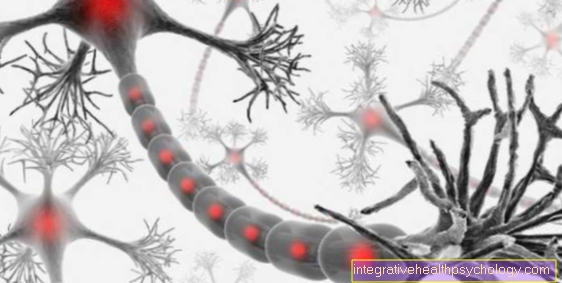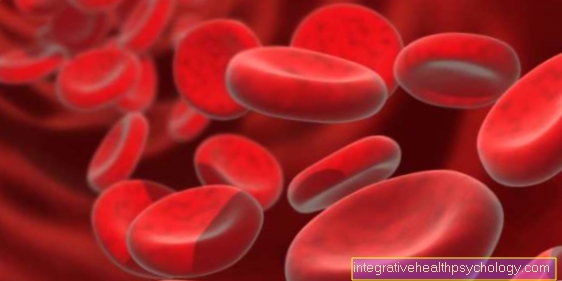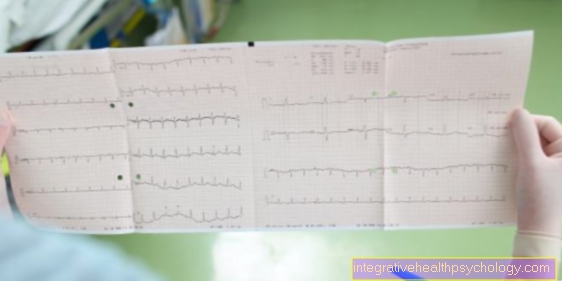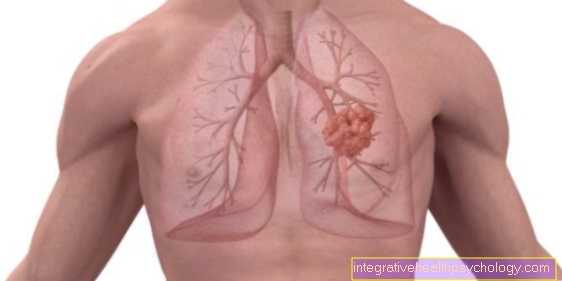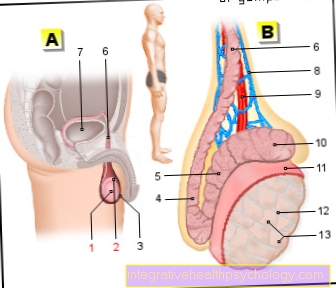Symptoms of Addison's disease
Typical symptoms of Addison's disease
The typical symptoms of Addison's disease are caused by a lack of vital messenger substances such as mineral corticoids and glucocorticoids. Only when over 90% of the adrenal cortex has been destroyed do the symptoms of Addison's disease show in their full expression. These include:
- decreased blood pressure
- Unintended weight loss
- Symptoms of dehydration - These can manifest themselves through very dry skin and mucous membranes, confusion, nausea and dizziness
- General weakness, also known as adynamia
- Pigmentation of the skin and mucous membranes
- Hunger for salt is very typical of the disease
- Hyperacidity
- Psychological changes / depression
- In women, armpit and pubic hair can be lost
In the context of a so-called Addison's crisis, which is a highly acute clinical picture, there are disorders of consciousness, nausea, vomiting, diarrhea and a sharp drop in blood pressure. The Addison crisis is a life threatening condition.

Drop in blood pressure
Addison's disease is characterized by very low blood pressure values. This drop in blood pressure is mainly caused by two mechanisms. In Addison's disease, there is no production of so-called mineral corticoids in the adrenal cortex. In the kidneys, these messenger substances ensure that water from the urine is reabsorbed into the bloodstream. If that doesn't happen, there is a lack of volume in the bloodstream, which causes blood pressure to drop.
Furthermore, the production of glucocorticoids, which also affect blood pressure, is restricted. As a result, the blood pressure continues to drop and there is sometimes a very sharp drop in blood pressure. An Addison's crisis, i.e. an acute lack of glucocorticoids, can even lead to a circulatory shock.
Dehydration
People who have Addison's disease have increased water loss. This can be explained as follows: In Addison's disease, the production of messenger substances called mineral corticoids is reduced. These messenger substances cause the urine to concentrate and water to be absorbed back into the bloodstream. If there is a lack of mineral corticoids, more water is excreted in the urine. The consequences are very dry skin, dry mucous membranes, a feeling of weakness and circulatory problems.
Headaches and nausea are typical symptoms of this dehydration.
Diarrhea and vomiting
Addison's disease as such can be associated with various complaints of the gastrointestinal tract. Nausea and bulging pain or acute symptoms such as vomiting and diarrhea can occur.
An Addison's crisis can lead to severe diarrhea and vomiting, which can lead to life-threatening fluid loss. Especially people who suffer from a latent form of Addison's disease, i.e. an asymptomatic form, can get into an acute Addison crisis due to stress, infections or operations, for example.
stomach pain
Symptoms of the gastrointestinal tract are also typical of Addison's disease.
The worst abdominal pain can occur in the context of an Addison crisis. This severe abdominal pain is also known as "acute abdomen" in medical terminology. They are accompanied by an abdominal wall that is extremely painful and hardened. This is also known as defensive tension. This type of abdominal pain is caused by the metabolic situation, which is in a severe imbalance in Addison's disease.
Hyperpigmentation
A shift in the hormonal balance typically leads to hyperpigmentation of the skin and mucous membranes in Addison's disease. This is expressed by a brownish discoloration, which, in contrast to a suntan, is also found on areas of the skin that are not exposed to the sun. This includes, for example, the palms and feet.
The reduced production of cortisol means that more melanocyte-stimulating hormone (MSH) is produced. This hormone stimulates the skin's melanocytes to store more pigment, which results in the brownish discoloration, even if the skin is not directly exposed to light.
Mental changes and depression
Addison's disease can not only lead to physical symptoms, but also typical psychological abnormalities in those affected. Above all, this includes a depressed mood, as well as general irritability and lethargy.
The psychological symptoms worsen even with poor physical condition or additional stress. In such situations, the metabolism of Addison's disease also deteriorates and there is an increased need for cortisol, which cannot be covered by the body's own production. Psychological abnormalities in Addison's disease should therefore be taken seriously and the therapy concept adapted accordingly.
Hyperacidity
Addison's disease can lead to a so-called acidotic metabolic condition, which can simply be described as hyperacidity. The main reason for this is as follows: Addison's disease has a deficiency in the hormone aldosterone. This promotes the excretion of potassium in the urine in the kidneys. As aldosterone is decreased and thus less potassium is excreted, the concentration of potassium in the body increases. Potassium causes the pH value in the blood to drop, i.e. it becomes more acidic. One then speaks of acidosis. This acidosis can be detected by a blood gas analysis.
Can hypoglycaemia occur in the context of Addison's disease?
Low blood sugar, which is also known as hypoglycemia in medical terminology, is usually only to be feared in the event of an Addison crisis. It is caused by an acute lack of cortisol. The hormone cortisol leads to an increase in blood sugar via various mechanisms.
In the case of an Addison's crisis in the context of Addison's disease, on the other hand, the lack of cortisol leads to a hypoglycemic metabolic situation, i.e. a severely reduced blood sugar.
Urinary retention- can this occur with Addison's disease?
Urinary retention is an acute emergency. Sufferers are unable to urinate and complain of severe abdominal pain. Addison's disease does not lead to urinary retention, but rather to reduced urine output in the context of the Addison crisis. People are able to urinate, but the amount of urine is decreased. This is explained by an acute circulatory shock in the context of the cortisol deficiency.
Low consciousness or coma in Addison's disease
In Addison's disease, various causes can lead to an acute clouding of consciousness up to a coma. Such an acute form of Addison's disease is also known as Addison's crisis. The cause of such a crisis is an acute lack of cortisol. Infections, increased physical exertion, operations or other illnesses can trigger such a life-threatening crisis in Addison's disease.
Various consequences of an acute cortisol deficiency, such as a sharp drop in blood pressure and blood sugar, as well as an acute lack of fluids, ultimately lead to a clouding of consciousness and, in the worst case, to a comatose state.
therapy
Treatment of primary adrenal insufficiency consists in replacing the missing substances. The glucocorticoid deficiency must be prevented by an oral intake of 20-30 mg cortisone be substituted on the day. The natural fluctuation of the cortisone level is taken into account: 20 mg in the morning, 10 mg in the evening. This is supplemented by taking in the evening Dexamethasone whose dosage is adapted to activities and special situations (e.g. operations, infections).
Also the Mineral corticoids can be replaced by medication and the dose adjusted to the various loads.
The patient should be given an Addison passport and always carry it with them. Detailed information and training for the patient and their relatives is recommended in order to be able to react competently in stressful situations.
Prognosis of Addison's disease
Primary adrenal insufficiency is fatal if left untreated. The substitution of hormones has to be lifelong. If medication is taken regularly and the dosage adjusted to the different situations, those affected can expect a normal life expectancy.
Diagnosis of Addison's disease
If Addison's disease is suspected due to the symptoms present, a blood sample is first analyzed. In primary adrenal insufficiency, the following blood parameters are changed:
- Low sodium
- Potassium increased
- ACTH increased
- Cortisol decreased
- Detection of antibodies
It is essential to know whether there is a primary, secondary or even tertiary form of adrenal insufficiency. To clarify this, on the one hand the symptoms are indicative. The diagnosis of Addison's disease still needs to be confirmed by further tests.
The so-called ACTH stimulation test is used to clarify the suspicion of adrenal insufficiency. If the cortisol value is above 200 µg / l after 60 minutes, adrenal insufficiency is excluded. If the cortisol level is below a certain value (less than 200µg / l) after 60 minutes after stimulation, there is an insufficiency. After that, the concentration of the ACTH is crucial.
If the values are normal or high, there is a primary form; if the value is lower, there is a secondary or tertiary form.
The CRH test is used to differentiate between the secondary and tertiary forms of Addison's disease. If there is no or only a small increase in cortisol and ACTH, the secondary form is present, while the tertiary form is present when ACTH increases and Korstiol shows no or only a slight increase.
Find out all about the topic here: ACTH.
Complications: Addison's crisis
A life-threatening condition is acute hypoadrenalism or Addison's coma. This Addison's crisis can be triggered by infections caused by certain pathogens (e.g. meningococcal sepsis) or with an existing adrenal insufficiency with additional stress. Additional stress refers to trauma, operations or infections. In general, this means stressful situations.
An Addison's crisis manifests as a loss of consciousness with fever, dehydration, and hypoglycaemia and can range to shock. Shock can be fatal.




